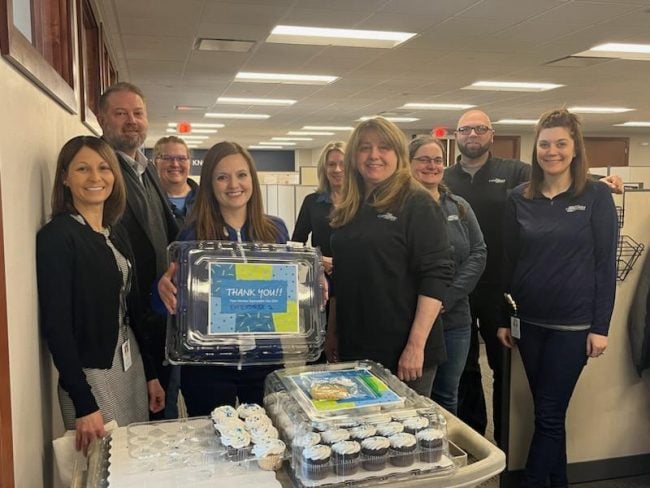 Teenager Eva Baker made what manyof her peers would consider the ultimate sacrifice – getting upearly on Saturday morning.
Teenager Eva Baker made what manyof her peers would consider the ultimate sacrifice – getting upearly on Saturday morning.
Baker (pictured at left) pulled on her 121 Financial CreditUnion shirt and headed for Mad City Money, a two-hour eventsponsored for teens by the Northeast Florida Chapter of the Leagueof Southeastern Credit Unions.
|Attendees received packets detailing information about ahypothetical life – profession, income, number of children, debts,and what their spouse earns. After determining how much money theyhad to spend, they visited a series of stations representingvarious items such as groceries.
|The idea was to make all the necessary purchases – fromchildren's shoes to rent or mortgage – and still have $100 left ina checking account.But Baker wasn't just one of the attendees. Sheis a blogger who writes the TeensGotCents Website and was asked torepresent 121 at the event. In fact, she teams with the creditunion on the site – but with some parameters. She is savvy enoughto insist that the blog is hers, and she has the final say on whatappears.
|Her next blog told readers about Mad City Money. The siterecords 3,000 hits a month. It's an example of how credit unionsare updating their efforts to appeal to teenagers. Another effort,Zard, has been created by State Employees' Credit Union in NorthCarolina. That program has attracted 100,000 teens.
|Cindy Breslin, vice president of marketing at the $443 million121 in Jacksonville, Fla., explained she read an article in theFlorida Times-Union about Baker, her blog, and her interest ineducating teenagers about financial issues.
|The credit union contacted her and asked if she would beinterested in partnering with a credit union. Baker agreed, butexplained she wanted autonomy.
|“We sort of monitor what she's interested in or what we thinkteens would be interested in,” Breslin explained. “We forwardinformation to her and she's free to use it or not. I think once asite becomes commercialized, it's not of interest to teens anymore.
|“We were fortunate recently that we had an onsite car sale. Ididn't realize it at the time, but she was interested in buying acar. So she came to our car sale, and she's writing a series on herblog on car shopping. What's she's doing is all real.”
|The key to the success of Baker's blog seems to be that it ispeer to peer, not an adult lecturing. So Berline doesn't want tofeed topics to her.
|“It's radically different from what we've been doing and I thinkit's the correct approach,” Breslin said. “Before we would writearticles or have seminars. Teens want to do things less and lessface to face. They want it when they want it. They believe theinformation they receive from Eva. It comes back to what's real andhow they relate to older people versus one of their own.”
|Just as the credit union gains from its relationship with Baker,Baker also benefits. For example, she was asked by a localorganization to conduct some classes for teens on budgeting andfinance. Baker called 121 and asked if the credit union could help.So 121 provided calculators, pens, pencils and shirts.
|Up in North Carolina, SECU's Zard program fits with the creditunion's FAT CAT program for young members. When a FAT CATparticipant reaches 13, they are automatically enrolled inZard.
|“It's a nice segue into their teen years,” said Leigh Brady, EVPfor organizational development at the $28.3 billion credit union inRaleigh. “It expands upon what we initially introduced in FAT CATwith additional financial services such as money market andchecking. They learn more through expanded topics. They have theirown website and newsletter.”
|SECU also works with parents to help them provide basicfinancial information to their teens. Sometimes that works. Butteens know adults can be pretty clueless.
|So another approach is financial education within the schools.In high school the credit union introduces reality fairs called TheReality of Money. It's very similar to the Mad City Money approach.Teens receive a piece of paper indicating they are, for instance, acomputer technician with two years of education and making acertain salary. They must decide what kind of car they're going topurchase, what kind of home they're going to live in, how much theyare going to spend on groceries, and so on.
|“It's really the harsh reality of how much it costs to live,”Brady said. “Not only does it help convince them they need to stayin school, it helps them understand how far a dollar goes ordoesn't go. It's a great approach to financial education and we'vehad a lot of success with that.
|“They realize they're going to have to make decisions anddecisions involving money aren't as easy as they thought they wouldbe. Teenagers, and I think even pre-teens, have a vested interestin money in general. They see the power of spending and saving. Ithink they recognize that earlier and earlier now.”
|Brady noted topics of most interest to teens are credit andcards. Forget keeping a check register and balancing a checkbook –they don't write checks.
|Most folks would agree financial education for teenagersbenefits them, but what's in it for the credit union?
|“When you introduce kids to financial services at an early age,and you establish a variety of ways you can go about providing goodinformation to them and offering quality low-cost services, it'sgoing to make them a better financially savvy member,” Bradyresponded.
|“Topics such as risk-based lending and how to purchase a car canbe introduced. I might not remember everything you tell me aboutpurchasing a car. But I remember I can go to the credit union andthey'll tell me about that. They'll see the value of a credit unionand what a credit union can provide.”
|Brady sketches an upbeat picture of what programs to attractyoung people can mean to the credit union. She would love to seeevery one of the FAT CAT and Zard members use SECU going forward asthey get jobs, marry thus adding their spouse to the credit union,have kids who join, and broaden the membership base.
|“If you don't get them early, someone else will,” shewarned.
Complete your profile to continue reading and get FREE access to CUTimes.com, part of your ALM digital membership.
Your access to unlimited CUTimes.com content isn’t changing.
Once you are an ALM digital member, you’ll receive:
- Critical CUTimes.com information including comprehensive product and service provider listings via the Marketplace Directory, CU Careers, resources from industry leaders, webcasts, and breaking news, analysis and more with our informative Newsletters.
- Exclusive discounts on ALM and CU Times events.
- Access to other award-winning ALM websites including Law.com and GlobeSt.com.
Already have an account? Sign In
© 2024 ALM Global, LLC, All Rights Reserved. Request academic re-use from www.copyright.com. All other uses, submit a request to [email protected]. For more information visit Asset & Logo Licensing.









